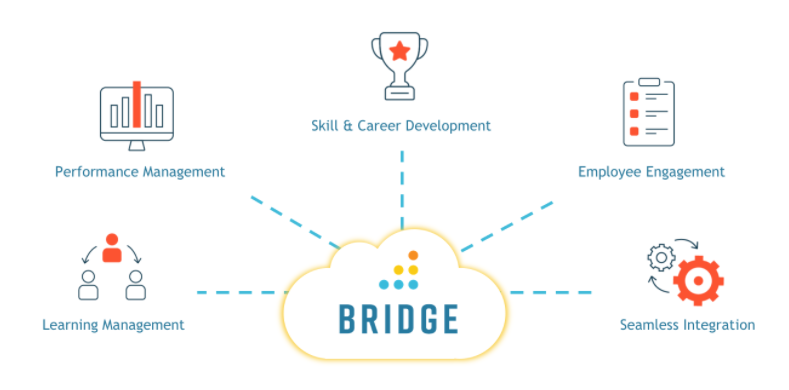Piers Lea, LTG’s Chief Strategy Officer, and Tim Martin, LTG’s Chief Innovation & Product Officer, go ‘behind the deal’ on how the acquisition of Bridge expands LTG’s performance and learning offering.
On February 26, 2021, LTG acquired Bridge, a learning, performance and skills development platform for mid-enterprise organisations, from Instructure Inc.
Bridge allows customers to create employee experiences at speed that drive compliance, productivity, and growth, and specialises in employee-centric experiences. The offering includes a learning management system in addition to performance, engagement and career development products – delivered to customers in a single, easy-to-use, SaaS-based platform.
Here, we explain why LTG was so keen on this acquisition and give more insights into how the integration and market proposition are shaping up.
Why did LTG acquire Bridge?
Bridge is a perfect strategic fit with LTG’s strategy. Bridge’s offering of learning, performance and skills for the mid-market complements LTG’s broader talent management offering. The cherry on top is that Bridge’s design is entirely people-focused (as opposed to HR-focused)!
The addition of Bridge continues LTG’s strategy of combining a group of businesses that help customers solve the critical and fast-moving challenge that is facing leadership in the workplace.
In our white paper, ‘A Human Framework for Reskilling: How 5 Seismic Forces Are Driving the Reinvention of Learning & Talent’, we describe these “seismic forces”:
- The complexity of business and work
- The pace of change
- Unprecedented demographic shifts
- The need to compete through productivity
- Changing relationships to work
These drivers are being accelerated by the effects of COVID-19 and the requirement to deliver a great employee experience to a more remote workforce. These kinds of systems used to be just the domain of large enterprise.
But no more…
Now, the fastest-growing market for learning and performance systems is in the mid-enterprise (sometimes defined as mid-market. For us, this means organisations with 1,000-5,000 people). Bridge provides LTG with the perfect platform for this market segment. PeopleFluent Learning will continue to service larger-enterprise customers that demand tailored solutions to meet their unique needs, including complex configurations, integrations and security requirements.
With its heritage in a business steeped in the education sector (via Instructure1), we like both the quality of the thought that’s gone into designing an excellent user experience at the same time as holding true to principles of good learning design.
The design team has taken great care to focus on the differences required for the workplace and, in particular, to give LTG a market-beating foundation for creating a measurable link to performance and engagement for this segment of the market. The Bridge method involves taking users on ‘journeys’ – a concept we’ve always liked in the learning space, but which also works so well in enabling people to shape their own careers.
What makes Bridge special?
The system comes with several key benefits for the mid-enterprise market. It’s fast to deploy, completely user-focused in its design and – as already stated – combines learning with performance and engagement.
Bridge is configurable enough to support a customer’s career development and learning programmes (including compliance) without eroding usability. Being intuitive to use drives engagement and take-up. This is crucial in organisations with less well developed L&D departments where learning is becoming increasingly learner-driven and woven into the day-to-day operations. This is sometimes described as enabling ‘learning in the flow of work’. The industry analyst who coined this term, Josh Bersin, made the following assessment:
“Bridge now offers one of the most elegant end-to-end talent and learning platforms I’ve seen for mid-sized companies.”
What makes the system special is the way it looks at the world of work through the lens of the employee.
President of LTG’s Learning & Talent Solutions division, Stephen Bruce, says: “As an industry, we need to think about talent solutions through the lens of the employee and their unique needs, as compared to the needs of the organisation. This includes how employees join the company, acclimate themselves, connect with others, collaborate and develop their skills, get recognised and rewarded and, ultimately, are presented with new opportunities that advance their careers.”
He adds: “I think Bridge (and its philosophy that “People Matter Most”) aligns clearly with the long-term vision that we have across all market segments: to provide solutions that are the next evolution of talent management, creating employee experiences that foster career development, internal mobility and growth. This means not only covering all the transactional and compliance processes that have to be done by HR to meet organisational needs (because that’s critical!) but also to present an employee destination that is tailored uniquely and differently for the people in the business.”
Bridge manages to balance the needs of the individual with the needs of the organisation by providing an all-in-one learning, performance and engagement platform:

In addition to all this, Bridge brings 800 new customers and a hugely talented team to the LTG family.
Peter Brussard, President of Bridge, says, ”The LTG family is really the right home for the Bridge product. There are so many synergies (in fact, we were already Rustici customers) across the portfolio that we will be able to realise quickly, and that’s very exciting. I’m also confident that our people-first approach to software development will bloom nicely in this environment.”
We look forward to updating the market as we move forward with this very exciting acquisition.
1 Instructure, which brought Canvas, the successful education system to the market, created Bridge to focus on learning and performance in the workplace.